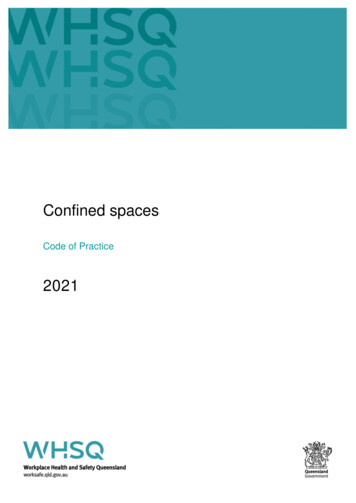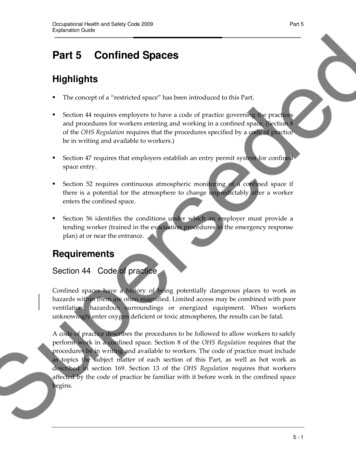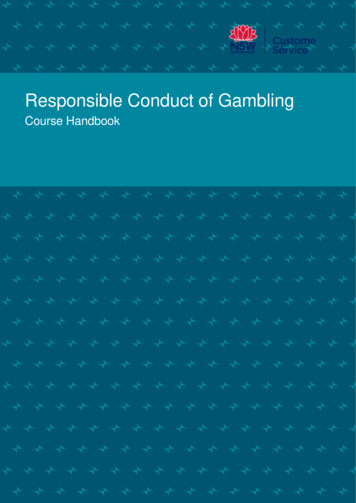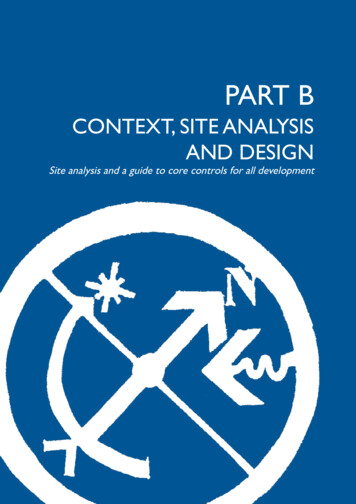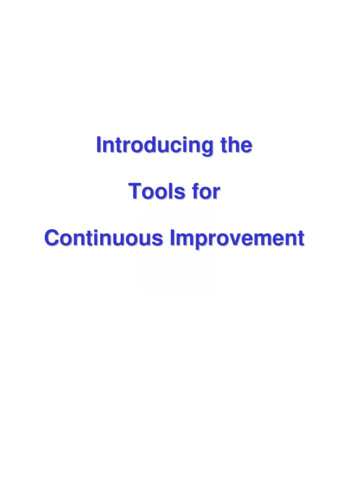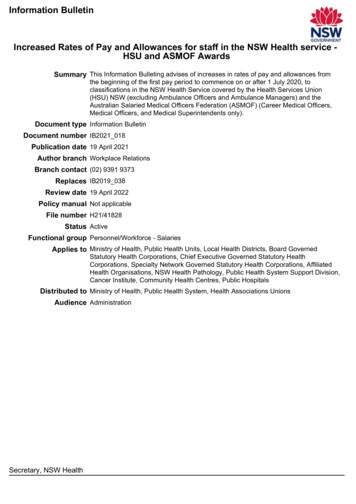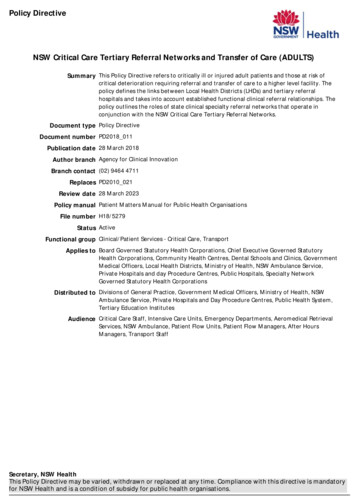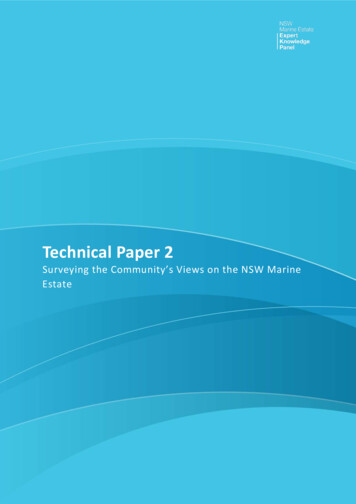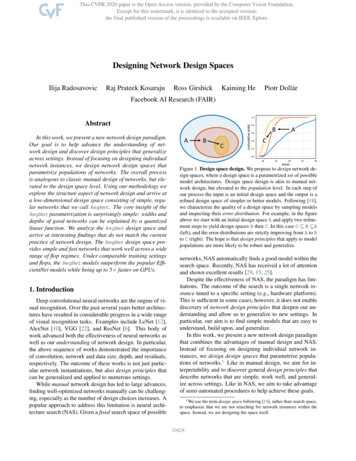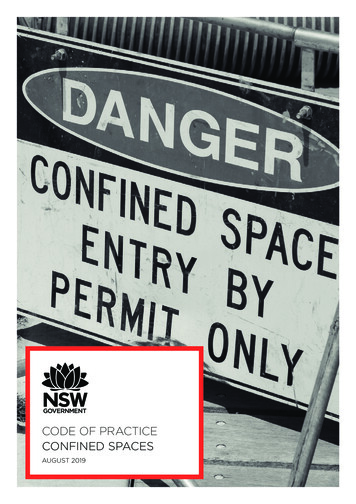
Transcription
CODE OF PRACTICECONFINED SPACESAUGUST 2019
NSW note: This code is based on a national model code of practice developed by Safe Work Australiaunder the harmonisation of national work health and safety legislation and has been approved undersection 274 of the NSW Work Health and Safety Act 2011. Notice of that approval was published inthe NSW Government Gazette referring to this code of practice as Confined spaces (page 7194) onFriday 16 December 2011. This code of practice commenced on 1 January 2012.Subsequent amendments under section 274 of the NSW Work Health and Safety Act 2011 have beenpublished and commenced as detailed in the list of amendments contained in this code.Except for the NSW Government logo, this copyright work is licensed under a Creative CommonsAttribution-Non-Commercial 3.0 Australia License.To view a copy of this licence, visit www.creativecommons.org/licenses/by-nc/3.0/auYou are free to copy, communicate and adapt the work for non-commercial purposes, as long as youattribute the work to SafeWork NSW and abide by the other licence terms.
ContentsForeword . 41. Introduction . 51.1.What is a confined space? . 51.2.Who has health and safety duties in relation to confined spaces? . 71.3.What is involved in managing risks associated with working in confined spaces? .1.4.Information, training, instruction and supervision . 122. Duty of designers, manufacturers, importers, suppliers, installers andconstructors . 142.1.Eliminating or minimising the need to enter a confined space. 142.2.Entry and exit . 143. The risk management process . 163.1.Identifying the hazards . 163.2.What hazards are associated with a confined space? . 173.3.Other hazards . 193.4.Assessing the risks. 214. Controlling the risks . 254.1.Eliminate the need to enter a confined space . 264.2.Minimise the risks . 264.3.Entry permits . 274.4.Isolation . 294.5.Atmosphere . 334.6.Communication and safety monitoring . 354.7.Entry and exit procedures . 364.8.Signs and barricades . 364.9.Maintaining and reviewing control measures . 375. Emergency procedures. 39Appendix A—Glossary . 41Appendix B—Confined space criteria . 43Appendix C—Sample confined space entry permit . 44List of amendments . 53Confined spacesCode of PracticePage 3 of 5410
ForewordThis Code of Practice on how to manage the risks associated with confined spaces in theworkplace is an approved code of practice under section 274 of the Work Health and SafetyAct (WHS Act).An approved code of practice provides practical guidance on how to achieve the standardsof work health and safety required under the WHS Act and the Work Health and SafetyRegulation (the WHS Regulation) and effective ways to identify and manage risks.A code of practice can assist anyone who has a duty of care in the circumstances describedin the code of practice. Following an approved code of practice will assist the duty holder toachieve compliance with the health and safety duties in the WHS Act and WHS Regulation,in relation to the subject matter of the code of practice. Like regulations, codes of practicedeal with particular issues and may not cover all relevant hazards or risks. The health andsafety duties require duty holders to consider all risks associated with work, not only thosefor which regulations and codes of practice exist.Codes of practice are admissible in court proceedings under the WHS Act and WHSRegulation. Courts may regard a code of practice as evidence of what is known about ahazard, risk, risk assessment or risk control and may rely on the code in determining what isreasonably practicable in the circumstances to which the code of practice relates. For furtherinformation see the Interpretive Guideline: The meaning of ‘reasonably practicable’.Compliance with the WHS Act and WHS Regulation may be achieved by following anothermethod if it provides an equivalent or higher standard of work health and safety than thecode.An inspector may refer to an approved code of practice when issuing an improvement orprohibition notice.Scope and applicationThis Code is intended to be read by a person conducting a business or undertaking (PCBU).It provides practical guidance to PCBUs on how to manage health and safety risksassociated with work carried out in a confined space.This Code may be a useful reference for other persons interested in the duties under theWHS Act and WHS Regulation.This Code applies to all workplaces covered by the WHS Act where work is carried out inconfined spaces.How to use this Code of PracticeThis Code includes references to the legal requirements under the WHS Act and WHSRegulation. These are included for convenience only and should not be relied on in place ofthe full text of the WHS Act or WHS Regulation. The words ‘must’, ‘requires’ or ‘mandatory’indicate a legal requirement exists that must be complied with.The word ‘should’ is used in this Code to indicate a recommended course of action, while‘may’ is used to indicate an optional course of action.Confined spacesCode of PracticePage 4 of 54
1. IntroductionConfined spaces pose dangers because they are usually not designed to be areas wherepeople work. Confined spaces often have poor ventilation which allows hazardousatmospheres to quickly develop, especially if the space is small. The hazards are not alwaysobvious and may change from one entry into the confined space to the next.The risks of working in confined spaces include loss of consciousness, impairment, injury ordeath from: the immediate effects of airborne contaminantsfire or explosion from the ignition of flammable contaminantsdifficulty rescuing and treating an injured or unconscious personoxygen deficiency or immersion in a free-flowing material, such as grain, sand, fertiliser,water or other liquidsfalls from a heightenvironmental factors, for example extremes in temperaturepoor lighting, andmanual handling.1.1. What is a confined space?WHS Regulation clause 5DefinitionsA ‘confined space’ means an enclosed or partially enclosed space that: is not designed or intended to be occupied by a personis, or is designed or intended to be, at normal atmospheric pressure while any person isin the space; andis or is likely to be a risk to health and safety from: an atmosphere that does not have a safe oxygen level, orcontaminants, including airborne gases, vapours and dusts, that may cause injuryfrom fire or explosion, orharmful concentrations of any airborne contaminants, orengulfment.A confined space is determined by the hazards associated with a set of specificcircumstances and not just because work is performed in a small space.Entry into a confined space means a person’s head or upper body is in the confined spaceor within the boundary of the confined space.Confined spaces are commonly found in vats, tanks, pits, pipes, ducts, flues, chimneys,silos, containers, pressure vessels, underground sewers, wet or dry wells, shafts, trenches,tunnels or other similar enclosed or partially enclosed structures, when these examples meetthe definition of a confined space in the WHS Regulation.Confined spacesCode of PracticePage 5 of 54
What is not a confined space for the purposes of the WHSRegulation?A confined space does not include a mine shaft or the workings of a mine.The following kinds of workplaces are also generally not confined spaces for the purposes ofthe WHS Regulation: places that are intended for human occupancy and have adequate ventilation, lightingand safe means of entry and exit, such as offices and workshopssome enclosed or partially enclosed spaces that at particular times have harmfulairborne contaminants but are designed for a person to occupy, for example abrasiveblasting or spray painting booths, andenclosed or partially enclosed spaces that are designed to be occasionally occupied by aperson if the space has a readily and conveniently accessible means of entry and exit viaa doorway at ground level, for example: a cool store accessed by a LPG powered forklift to move stock—although the use ofa LPG powered forklift in a cool store can be hazardous, the door at ground levelmeans that once the alarm is raised, escape and rescue can happen quickly, ora fumigated shipping container with a large ground level opening that will facilitateescape and rescue.Trenches are not considered confined spaces based on the risk of structural collapse alone,but will be confined spaces if they potentially contain concentrations of airbornecontaminants that may cause impairment, loss of consciousness or asphyxiation.How to determine whether a space is a confined spaceA confined space is determined by the structure and a specific set of circumstances. Thesame structure may or may not be a confined space depending on the circumstances whenthe space is entered. Entry to a confined space is considered to have occurred when aperson’s head or upper body enters the space.A space may become a confined space if work that is to be carried out in the space wouldgenerate harmful concentrations of airborne contaminants.Temporary control measures such as providing temporary ventilation or achieving asatisfactory pre-entry gas test will not cause a confined space to be declassified. For aconfined space to be declassified as a non-confined space, it needs to have undergonesufficient changes in structure and use to eliminate all inherent hazards that define aconfined space.The following flowchart will help to determine whether a space is a ‘confined space’ for thepurposes of the WHS Regulation.Appendix B provides examples to illustrate how a confined space is determined.Confined spacesCode of PracticePage 6 of 54
1.2. Who has health and safety duties in relationto confined spaces?Duty holders who have a role in managing the risks of working in confined spaces include: persons conducting a business or undertaking (PCBUs)Confined spacesCode of PracticePage 7 of 54
designers, manufacturers, importers, suppliers, installers and constructors of plant,substances or structures, andofficers.Workers and other persons at the workplace also have duties under the WHS Act, such asthe duty to take reasonable care for their own health and safety at the workplace.A person can have more than one duty and more than one person can have the same dutyat the same time.Early consultation and identification of risks can allow for more options to eliminate orminimise risks and reduce the associated costs.Person conducting a business or undertakingWHS Act section 19Primary duty of careA PCBU must eliminate risks arising from working in confined spaces, or if that is notreasonably practicable, minimise the risks so far as is reasonably practicable.The WHS Regulation includes more specific requirements for PCBUs to manage the risks ofhazardous chemicals, airborne contaminants and plant, as well as other hazards associatedwith confined spaces.PCBUs have a duty to consult workers about work health and safety and may also haveduties to consult, cooperate and coordinate with other duty holders.Designers, manufacturers, importers, suppliers, installers andconstructors of plant, substances or structuresWHS Act Part 2 Division 3Further duties of persons conducting businesses or undertakingsDesigners, manufacturers, importers, suppliers, installers and constructors of plant,substances or structures that include a space that is intended, or is likely to become aconfined space must ensure, so far as is reasonably practicable, the plant, substance orstructure they design, manufacture, import, supply or install is without risks to health andsafety. This duty includes carrying out testing and analysis as well as providing specificinf
A confined space is determined by the hazards associated with a set of specific circumstances and not just because work is performed in a small space. Entry into a confined space means a person’s head or upper body is in the confined space or within the boundary of the confined space. Confined spaces are commonly found in vats, tanks, pits, pipes, ducts, flues, chimneys, silos, containers .
